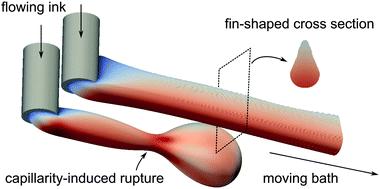当前位置:
X-MOL 学术
›
Soft Matter
›
论文详情
Our official English website, www.x-mol.net, welcomes your feedback! (Note: you will need to create a separate account there.)
Simulated filament shapes in embedded 3D printing
Soft Matter ( IF 3.4 ) Pub Date : 2021-07-22 , DOI: 10.1039/d1sm00731a Leanne M Friedrich 1 , Jonathan E Seppala 1
Soft Matter ( IF 3.4 ) Pub Date : 2021-07-22 , DOI: 10.1039/d1sm00731a Leanne M Friedrich 1 , Jonathan E Seppala 1
Affiliation

|
Embedded 3D printing, wherein fluid inks are extruded into support baths, has enabled the manufacture of complex, custom structures ranging from cell-laden tissue analogues to soft robots. This method encompasses two techniques: embedded ink writing (EIW), where filaments are extruded, and embedded droplet printing (EDP), where droplets are suspended. Materials for embedded 3D printing can be Newtonian, but often both the ink and the support bath are yield stress fluids, following elastic behavior below the yield stress and shear-thinning, viscous behavior above the yield stress. The effect of surface tension on print quality has been debated, as inks have been printed into supports at high and low surface tensions. In order to guide material selection for embedded 3D printing and identify key scaling relationships that influence print quality, this study investigates the role of ink rheology, support rheology, and surface tension on the morphology of single filaments. Numerical simulations in OpenFOAM demonstrate that at low viscosities, surface tension controls the filament morphology. Where capillarity is suppressed, the ratio of the local ink and support viscosities and the shape of the yield surface in the support control the filament shape. Herschel–Bulkley support fluids (yield stress fluids) produce more stable, accurately positioned filaments than Newtonian supports. In the short term, non-zero surface tensions can suppress filament shape defects in EIW and are essential for producing droplets in EDP.
中文翻译:

嵌入式 3D 打印中的模拟灯丝形状
嵌入式 3D 打印,其中流体墨水被挤出到支撑槽中,已经能够制造复杂的定制结构,从载有细胞的组织类似物到软机器人。该方法包括两种技术:嵌入式墨水书写 (EIW),其中挤出细丝,以及嵌入式液滴打印 (EDP),其中液滴悬浮。用于嵌入式 3D 打印的材料可以是牛顿材料,但通常墨水和支撑液都是屈服应力流体,在屈服应力以下遵循弹性行为,在屈服应力以上遵循剪切稀化、粘性行为。表面张力对印刷质量的影响一直存在争议,因为油墨已在高和低表面张力下印刷到支撑物中。为了指导嵌入式 3D 打印的材料选择并确定影响打印质量的关键比例关系,本研究调查了油墨流变学、支撑流变学和表面张力对单丝形态的作用。OpenFOAM 中的数值模拟表明,在低粘度下,表面张力控制细丝形态。在毛细作用被抑制的情况下,局部油墨和支撑物粘度的比率以及支撑物中屈服面的形状控制细丝形状。Herschel–Bulkley 支持流体(屈服应力流体)产生比牛顿支持更稳定、定位更准确的细丝。在短期内,非零表面张力可以抑制 EIW 中的细丝形状缺陷,并且对于在 EDP 中产生液滴至关重要。OpenFOAM 中的数值模拟表明,在低粘度下,表面张力控制细丝形态。在毛细作用被抑制的情况下,局部油墨和支撑物粘度的比率以及支撑物中屈服面的形状控制细丝形状。Herschel–Bulkley 支持流体(屈服应力流体)产生比牛顿支持更稳定、定位更准确的细丝。在短期内,非零表面张力可以抑制 EIW 中的细丝形状缺陷,并且对于在 EDP 中产生液滴至关重要。OpenFOAM 中的数值模拟表明,在低粘度下,表面张力控制细丝形态。在毛细作用被抑制的情况下,局部油墨和支撑物粘度的比率以及支撑物中屈服面的形状控制细丝形状。Herschel–Bulkley 支持流体(屈服应力流体)产生比牛顿支持更稳定、定位更准确的细丝。在短期内,非零表面张力可以抑制 EIW 中的细丝形状缺陷,并且对于在 EDP 中产生液滴至关重要。比牛顿支撑更精确定位的细丝。在短期内,非零表面张力可以抑制 EIW 中的细丝形状缺陷,并且对于在 EDP 中产生液滴至关重要。比牛顿支撑更精确定位的细丝。在短期内,非零表面张力可以抑制 EIW 中的细丝形状缺陷,并且对于在 EDP 中产生液滴至关重要。
更新日期:2021-07-23
中文翻译:

嵌入式 3D 打印中的模拟灯丝形状
嵌入式 3D 打印,其中流体墨水被挤出到支撑槽中,已经能够制造复杂的定制结构,从载有细胞的组织类似物到软机器人。该方法包括两种技术:嵌入式墨水书写 (EIW),其中挤出细丝,以及嵌入式液滴打印 (EDP),其中液滴悬浮。用于嵌入式 3D 打印的材料可以是牛顿材料,但通常墨水和支撑液都是屈服应力流体,在屈服应力以下遵循弹性行为,在屈服应力以上遵循剪切稀化、粘性行为。表面张力对印刷质量的影响一直存在争议,因为油墨已在高和低表面张力下印刷到支撑物中。为了指导嵌入式 3D 打印的材料选择并确定影响打印质量的关键比例关系,本研究调查了油墨流变学、支撑流变学和表面张力对单丝形态的作用。OpenFOAM 中的数值模拟表明,在低粘度下,表面张力控制细丝形态。在毛细作用被抑制的情况下,局部油墨和支撑物粘度的比率以及支撑物中屈服面的形状控制细丝形状。Herschel–Bulkley 支持流体(屈服应力流体)产生比牛顿支持更稳定、定位更准确的细丝。在短期内,非零表面张力可以抑制 EIW 中的细丝形状缺陷,并且对于在 EDP 中产生液滴至关重要。OpenFOAM 中的数值模拟表明,在低粘度下,表面张力控制细丝形态。在毛细作用被抑制的情况下,局部油墨和支撑物粘度的比率以及支撑物中屈服面的形状控制细丝形状。Herschel–Bulkley 支持流体(屈服应力流体)产生比牛顿支持更稳定、定位更准确的细丝。在短期内,非零表面张力可以抑制 EIW 中的细丝形状缺陷,并且对于在 EDP 中产生液滴至关重要。OpenFOAM 中的数值模拟表明,在低粘度下,表面张力控制细丝形态。在毛细作用被抑制的情况下,局部油墨和支撑物粘度的比率以及支撑物中屈服面的形状控制细丝形状。Herschel–Bulkley 支持流体(屈服应力流体)产生比牛顿支持更稳定、定位更准确的细丝。在短期内,非零表面张力可以抑制 EIW 中的细丝形状缺陷,并且对于在 EDP 中产生液滴至关重要。比牛顿支撑更精确定位的细丝。在短期内,非零表面张力可以抑制 EIW 中的细丝形状缺陷,并且对于在 EDP 中产生液滴至关重要。比牛顿支撑更精确定位的细丝。在短期内,非零表面张力可以抑制 EIW 中的细丝形状缺陷,并且对于在 EDP 中产生液滴至关重要。


























 京公网安备 11010802027423号
京公网安备 11010802027423号